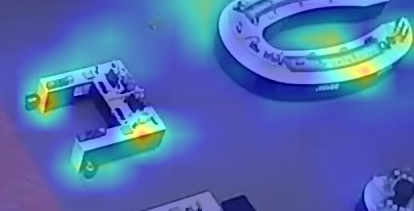
SAS' Jordan Leiker shows you how any CAS action can be used with image data to create heat maps.

SAS' Jordan Leiker shows you how any CAS action can be used with image data to create heat maps.

SAS' Hamza Ghadyali reveals how to build computer vision solutions with privacy baked into their design.

In the second of two Q&As with R&D colleagues, SAS' Udo Sglavo provides a window into how we approach drug-development challenges with machine learning.

A note from Udo Sglavo: At SAS, what we deliver to our customers is a product of creative minds thinking differently, challenging the norm, taking risks, and learning from trial and error (The greatest teacher, failure is). For the return of World Creativity & Innovation Week, we want to share

SAS' Brian Gaines provides a primer on GAMs.

SAS' Xuejun Liao weighs the pros and cons of collaborative filtering and supervised learning and explores their use in a unified framework.

SAS' Courtney Ambrozic highlights how to use SAS VDMML to assess lesion response to chemotherapy for patients with colorectal liver cancer.

SAS' Pankaj Telang shows you new image-specific processing capabilities in SAS Visual Data Mining and Machine Learning.

SAS' Yongqiao Xiao, Maggie Cech and Patrick Koch describe an ONNX model in ASTORE and demonstrate how to use the information to save an ONNX model to an analytic store.

SAS' Kelly Fellingham, an advanced analytics software developer, reveals how SAS software's new SASEBEA interface helps you identify patterns in US economics data.

In a Q&A with SAS' Udo Sglavo, Xilong Chen of SAS parses the work of 2021 Nobel Prize winners for Economics.

SAS' Hamza Ghadyali introduces you to JupICL, a SAS field-tested, easy-to-use, customizable image labelling tool that runs entirely inside a Jupyter notebook.

SAS' Rajesh Selukar introduces you to a new scoring feature.

SAS' Bahar Biller, an operations researcher, details how to develop a supply chain digital twin.

SAS' Udo Sglavo and Jan Chvosta discuss the power of a regression framework and choosing the correct regression model.

SAS' Udo Sglavo interviews colleague Jan Chvosta, director of Scientific Computing at SAS, on regression analysis and how it works.

SAS' Xilong Chen introduces the new DEEPCAUSAL procedure in SAS Econometrics for causal inference and policy evaluation and much more.

SAS' Ghohui Wu shows you how to construct spatial weights matrices based on contiguity and distance measures, then shows how PROC CSPATIALREG automates spatial regression model selection.
SAS' Fijoy Vadakkumpadan, a computer vision expert, sheds light on how loadImages works in SAS Viya.

This is the second post in a series covering parallel processing in SAS Viya. The first post served as an introduction to parallel processing. It covered parallel processing uses in data science and the SAS Viya products that facilitate it. There are countless opportunities for using parallel processing within data

The computer vision team was recently presented with the following challenge concerning image matching performance. An insurance company has the capability to submit claims and supporting materials digitally via an online interface. They need, however, to be able to detect when images already used in previous claims have been resubmitted

Learn how a computer vision application makes it safer, post-pandemic, for employees to return to factories.

Recently, we’ve released a new feature in ASTORE: score with multiple analytic stores. In the process, we may create multiple analytic stores with dependencies among them (the output of some analytic stores is an input to others). This feature streamlines the scoring process of multiple analytic stores. It enables the

Most computers can execute operations in parallel due to their multicore infrastructure. Performing more than one operation simultaneously has the potential to speed up most tasks and has many practical uses within the field of data science. SAS Viya offers several products that facilitate parallel task execution. Many of these

Note from Gül Ege Sr. Director, Analytics R&D, IoT: The pattern of training in the Cloud, with your choices of framework and inferencing at the Edge with a target environment, are especially common in Internet of Things (IoT). In IoT, there is a proliferation of hardware environments on the Edge.

In the second of two posts spotlighting SAS R&D innovators, SAS' Udo Sglavo interviews Chris Barefoot, Matthew Galati, Courtney Ambrozic and Davood Hajinezhad.

In the first of two posts spotlighting SAS R&D innovators, SAS' Udo Sglavo introduces you to developers Amy Shi, Maggie Du and Phil Helmkamp.

Machine Learning models are becoming widely used to formulate and describe processes’ key metrics across different industry fields. There is also an increasing need for the integration of these Machine Learning (ML) models with other Advanced Analytics methodologies, such as Optimization. Specifically, in the manufacturing industry, SAS explored state-of-the-art science

Linear programming (LP) and mixed integer linear programming (MILP) solvers are powerful tools. Many real-world business problems, including facility location, production planning, job scheduling, and vehicle routing, naturally lead to linear optimization models. Sometimes a model that is not quite linear can be transformed to an equivalent linear model to reduce

Note from Udo Sglavo: In our peace of mind blog series, we documented areas of analytics that are either evolving or not necessarily in the standard toolset of data scientists. We looked at causal modeling, network analytics, and econometrics, to name a few. With this blog post, we would like